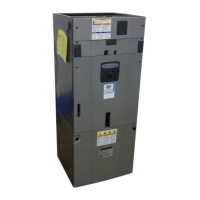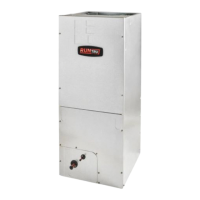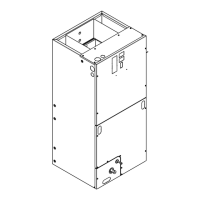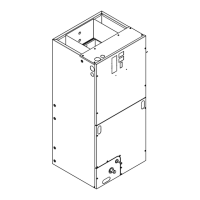AM7A0C36H31-SF-1A 4
5. The EVC will receive input from the two temperature sen-
sors and start to control 1st stage superheat.
6. R-Y2contactscloseonthecomfortcontrolsending
24VACtoY2terminalontheAFC.TheAFCcommuni-
cates to the EVC to control superheat for 2nd stage.
7. TheY2signalispassedthroughtoprovidepowertothe
outdoor unit 2nd stage control circuit.
8. The blower motor will now run at 100% of the cooling
cfm.
Cooling OD 1 stage
1. R-Ycontactscloseonthecomfortcontrolsending24VAC
toY1terminalontheAFC.
2. Normally closed contacts on the AFC will pass 24VAC
totheYOterminalprovidingpowertotheoutdoorunit
control circuit.
3. R-G contacts close on the comfort control sending
24VAC to the G terminal of the AFC.
4. The AFC micro-processor sends a command to the serial
communicating blower motor to run at 100% of the cool-
ing cfm.
5. The EVC will receive input from the two temperature sen-
sors and start to control superheat.
Cooling OD Two stage
9. R-Y1contactscloseonthecomfortcontrolsending
24VACtoY1terminalontheAFC.TheAFCcommuni-
cates to the EVC to control superheat for 1st stage.
10. Normally closed contacts on the AFC will pass 24VAC to
theYOterminalprovidingpowertotheoutdoorunit1st
stage control circuit.
11. R-G contacts close on comfort control sending 24VAC to
the G terminal of the AFC.
12. The AFC micro-processor sends a command to the se-
rial communicating blower motor to run at the 1st stage
cooling cfm. (1st stage cooling cfm is a multiplier of 2nd
stage cfm)
13. The EVC will receive input from the two temperature sen-
sors and start to control 1st stage superheat.
14. R-Y2contactscloseonthecomfortcontrolsending
24VACtoY2terminalontheAFC.TheAFCcommuni-
cates to the EVC to control superheat for 2nd stage.
15. TheY2signalispassedthroughtoprovidepowertothe
outdoor unit 2nd stage control circuit.
16. The blower motor will now run at 100% of the cooling
cfm.
Electric Heat
1. R-W contacts close on the comfort control sending
24VAC to W1 of the AFC.
2. R-G contacts close on the comfort control sending
24VAC to G of the AFC.
3. The AFC communicates to the EHC that 1st stage elec-
tric heat is being called upon.
4. The EHC determines the number of elements that are
used for 1st stage and sends a message to the AFC for
that correct cfm. (The EHC determines the amount of
heat per stage by either factory programming or by the
kw jumper position)
5. The AFC micro-processor sends a command to the serial
communicating blower motor to run and close the blower
interlock relay. The blower motor will now run at the W1
electric heat cfm.
6. On subsequent calls for W2 and/or W3, the EHC will
communicatetotheAFCtherequiredairowrequestand
energize the additional relays.
NOTE: The EHC has “lead-lag” logic built in that energizes the
electric heat relays based upon cycle counts.
Forexample:BAYEV**15–ThersttimeW1onlyisener-
gized; the K1 relay would close and energize the “A”
heater. The second time W1 only is energized; the K2
relay would close and energize the “B” heater. The third
time W1 only is energized; the K3 relay would close and
energize the “C” heater.
Defrost
1. The OD unit will initiate defrost and send 24VAC to the O
terminal of the AFC.
2. The AFC will communicate to the EVC that the OD is
in defrost and the EVC will start to maintain the correct
superheat.
3. X2 from the OD will send 24VAC to W1 of the AFC.
4. The AFC communicates to the EHC that 1st stage elec-
tric heat is being called upon.
5. The EHC determines the number of elements that are
used for 1st stage and sends a message to the AFC for
that correct cfm.
Optional Condensate Switch
1. An optional OEM condensate switch can be installed
within the unit. This switch is only available through the
National Distribution Center or Global Parts.
2. Switch contacts are normally open and close when water
levelrises.Theclosedswitchwillinterruptcurrentowto
theYOterminalandde-energizetheODunit.
3. Switch is only operational during cooling mode. Conden-
sateoverowisnotoperationalduringheatingordefrost
modes.
Standard aftermarket condensate switches cannot be used
within the unit but can be installed exterior of the unit.
SwitchshouldbewiredinserieswithYOwiringtotheOD
unit.
Freeze Protection
1. The EVC control has the ability to sense when the coil is
beginning to ice. After 20 minutes of the evaporator tem-
peraturebelow32degrees,thecontactstotheYOcircuit
will open and de-energize the OD unit.
2. The indoor blower motor will continue to run to aid in
defrostingthecoil.After5minutes,theYOcontactswill
close and cooling operation will begin again.
Blower Delays
1. Blowerairowdelayscanbesettoenhancesystem
comfort and efficiency. See S2 dip switch settings table
on page 9.

